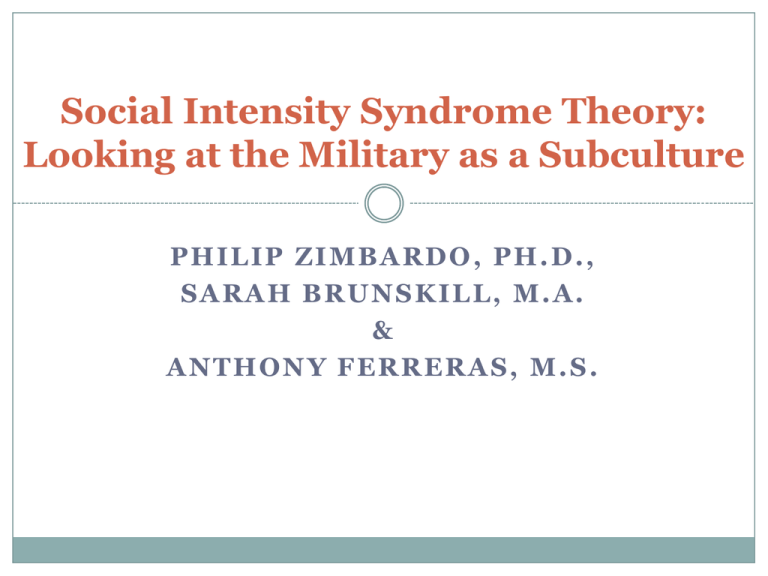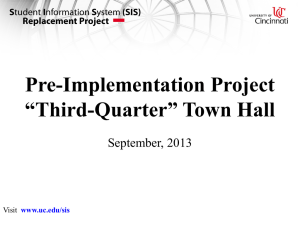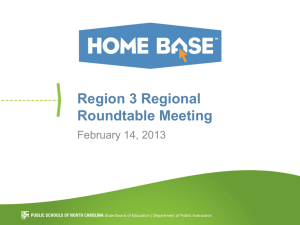
Social Intensity Syndrome Theory:
Looking at the Military as a Subculture
PHILIP ZIMBARDO, PH.D.,
SARAH BRUNSKILL, M.A.
&
ANTHONY FERRERAS, M.S.
Background
Past studies
The social environment has powerful effects on individual
behaviors and can often change the way they normally behave
E.g., Milgram Study, Stanford Prison Study
Each of the experiments, however, produced only
temporary changes in participants’ attitudes and
behaviors.
What about real life?
Social Experiments in Real Life
Real life situations are created and structured to
produce long lasting effects in people who
participate.
Religious cults
Military
Why?
The present study failed to find literature analyzing
the effects of the intense, long-term socialization that
happens in the military on Veterans’ lives beyond
their service
The purpose
Introduce a new theoretical concept that describes this social
phenomenon,
Explore its assumptions about intense and long-term effects of
military socialization.
The composite of causes and effects related to long-term
military socialization is new to academia and is referred to
here as Social Intensity Syndrome (SIS).
What is SIS?
Social Intensity Syndrome (SIS) –
Is the descriptive term for the complex of values, attitudes,
and behaviors organized around personal attraction to and
desire to maintain association with Male dominated social
groupings.
WHERE DID THE IDEA COME FROM?
REPORTS OF SPOUSE AND FAMILY ABUSE
AMONG RETURNING VETS FROM OVERSEAS
HIGH RATES OF REDEPLOYMENT AMONG IRAQ
VETS BACK TO CONFLICT ZONES.
SOME VETS HAVE REDEPLOYED 4 AND 5 TIMES!
WHY?
WHERE ELSE DID THE IDEA COME
FROM?
My Fair Lady,
Rex Harrison singing WHY CAN’T A WOMAN BE
MORE LIKE A MAN?
Conceptual Assumptions
Men, are attracted to social settings that involve the
presence of a group of other men
2. That attraction is greater when:
1.
The more intense the nature of the relationship
The more exclusive it is of tolerating “outsiders” or those
who have not qualified for that group membership
The more embedded each man is perceived to be within that
group
1.
2.
3.
E.g., the military, deployment, gangs, contact team sports,
fraternities, prisons, some cults, and bars/ pubs.
Conceptual Assumptions
3. Men experience a positive arousal, when they feel
they are part of such an all MALE social group.
Cortisol, Adrenergic system activation, or testosterone
increase
4. Men adapt to that level of social intensity contact
as an optimally desired personal and social state.
5. Over time, that degree of social intensity becomes a
“set point” of desirable functioning, operating at a
non-conscious level.
Conceptual Assumptions
6. When separated from such socially intense group
settings, men experience a sense of …
Isolation and then boredom
Withdrawal symptoms
Which are greater the longer the prior duration of their group
participation
Behavioral Predictions
Those with high levels of SIS will do some or all of
the following:
1. Respond to the negative affect of disengagement
from such groups by engaging in:
Arousing activities (e.g., such as high risk ventures, daring
deeds, getting into arguments and fights, drinking to excess,
gambling, motorcycling, and similarly intense actions.)
2. Choose Male group activities over smaller pairings
of one or a few other men. (homo-avoidance)
3. Choose all men groupings over mixed gender ones.
Behavioral Predictions
4. Feel less comfortable in the presence of women as
“friends.” Women/spouse less trusted than men.
5. Spend more time in symbolic male groups,
E.g., watching sports in a sports bar, fantasy football or
baseball competitions.
6. Report high levels of boredom after separating
from the socially intense grouping.
7. Recall greater positive and fewer negative aspects
of one’s time in that group.
8. Deal with the arousal deficit by seeking
redeployment if in the military.
Behavioral Predictions
9. Deal with the arousal deficit by
Hanging around settings where there are likely to be other
men who also belong to such high intensity groupings
E.g., VA hospital lobbies, sports team “fanatics”, etc.
10. More likely to engage in
Spousal abuse
Divorced or separate from mates
11. More likely to experience
Alcoholism,
Drug addiction,
Commit crimes,
Suffer higher levels of PTSD
Behavioral Predictions
12. Men who are paroled from prison may engage in
crimes in which they are more likely to get caught
non-conscious attempt to return to the socially intense
prison atmosphere.
13. Develop generally negative attitudes toward
women as “the other” who do not understand them,
prefer pornography and sex with prostitutes over consensual
sexual relationships with equal status female mates.
Transitioning from Active to Inactive
The change is typically abrupt and without proper
training for dealing with their now “new other” life.
Military personnel leave the culture and enter
another for which they have little or no training to
deal with as independent, socially responsible
civilian adults
Find it difficult to relate to civilians
Find that ordinary life is boring, tedious, non challenging
Begin to social isolate themselves
Begin to feel inadequate, incompetent
AND NO ONE IS AWARE OF THE SIS TRAP AT WORK!
Lyrics from My Fair Lady: Reprise lamenting
the failure of women to be men
Why can't a woman be more like a man?
Men are so honest, so thoroughly square;
Eternally noble, historically fair.
Who, when you win, will always give your back a pat.
Why can't a woman be like that?
Why does every one do what the others do?
Can't a woman learn to use her head?
Why do they do everything their mothers do?
Why don't they grow up, well, like their father
instead?
Women would be more loved if they were
MEN
Why can't a woman take after a man?
Men are so pleasant, so easy to please.
Whenever you're with them, you're always at ease.
But by and large we are a marvelous sex!
Why can't a woman take after a man?
'Cause men are so friendly, good-natured and kind.
A better companion you never will find.
Why can't a woman be more like a man?
Men are so decent, such regular chaps;
Ready to help you through any mishaps;
Ready to buck you up whenever you're glum.
Why can't a woman be a chum? Why can't a woman be
like me?
Creating a New SIS Survey
SARAH R. BRUNSKILL, M.A.
Item writing and selection
150 preliminary items were created
Interviews with Veterans, military family members and
clinicians
Literature reviews
Received consultation from Veterans and active
military personnel
The criterion for item retention
Alignment with the theoretical assumptions
Appropriateness
Wording
Relevancy
Measures
1oo exploratory items
Intended to measure the various conceptual aspects of SIS.
Higher scores on this scale reflect/endorsed SIS
Used a 1 to 5 Likert type scale
“Disagree Strongly” to “Agree Strongly”
Length
Approximately 30 minutes
2 items needed to be reverse coded
Sample Question
Procedure
A group of 5 undergraduates and 1 PI contacted both
active and inactive military personnel through…
Websites,
Social media,
Personal contacts,
Military lists,
Veteran services,
Senior centers,
Education facilities,
Interest groups, est.
Recruitment
Snowball Method
friends, family, other acquaintances or
individuals lists on public websites as
the contact person for a military group
contacts asked to forward the letter to
their military network
recipients were asked to forward the
letter to others
Participants
N (survey hits)
n (completed surveys)
Female
Male
Missing items
Eligible surveys for analysis
618 (100%)
346 (56.0%)
11 (3.2%)
335 (96.8%)
11 (3.2%)
324 (52.4%)
Participant Demographics
n
(n = 324)
Age
18 to 24
25 to 35
26 to 45
46 to 55
56 to 65
66 to 75
76 and above
Ethnicity
African American
Asian/Pacific Islander
Caucasian
Hispanic/Latino
Other
16 (5.0%)
57 (17.8%)
55 (17.2%)
52 (16.3%)
70 (21.9%)
35 (10.9%)
35 (10.9%)
7 (2.2%)
46 (14.2%)
241 (74.6%)
19 (5.9%)
10 (3.1%)
Military Demographics
Military Branch
Air Force
Army
Coast Guard
Marine Corp
Navy
Category
Active/Not Deployed
Active/Deployed
Inactive/Not Deployed
Inactive/Deployed
n
(n = 324)
2010 Military
Census
92 (28.5%)
139 (43.0%)
5 (1.5%)
36 (11.1%)
51 (15.8%)
24.1%
39.8%
2.3%
10.2%
23.5%
17 (5.2%)
88 (27.2%)
45 (13.9%)
174 (53.7%)
Predicted Ranking of SIS
Higher SIS
Inactive/Deployed
Inactive/Non-deployed
Active/Deployed
Active/Non-deployed
Lower SIS
Data Screening
Data was screened for outliers
Minimum amount of data for analysis
Not satisfied
Need an estimated >500 cases
Exploratory preliminary factor analysis
Current N = 324
~3 cases per variable
Assumption Testing
Factorability
Kaiser-Meyer-Olkin
Bartlett’s test of sphericity
Anti-image correlation matrix
Communalities
Variance Explained
Scree Plot
Variance Explained With 3 Factors
Example of Items Eliminated
Question
Reason 1
I feel my best when with my MILITARY
friends.
Cross-loading on factors 1 and 2
Since being deployed, I am more
interested in connecting with my
MILITARY friends.
Cross-loading on factors 1 and 2
The guys I was close to in my unit
probably understand me better than
anyone else currently in my life.
Cross-loading on factors 1 and 2
I prefer to be around people most of the
time.
Cross-loading on factors 1 and 3
I enjoy playing extreme sports (e.g.,
skydiving, cliff diving, motorsports,
etc.).
Did not have a high enough factor
loading
Final Factor Analysis:
Assumption Testing
Factorability
Kaiser-Meyer-Olkin
Bartlett’s test of sphericity
Anti-image correlation matrix
Communalities
Final Factor Analysis:
Variance Explained
Reliability Analyses:
Factor 1
Title/theme – Trust
Number of items = 29
a = .954
Example Questions
Factor
Loading
It is easier to trust my MILITARY friends than my significant other
.779
It is hard for me to trust women
.742
I wish my significant other was more like my best MILITARY friends
.714
I distance myself from my NON-MILITARY friends
.633
I distance myself from my SIGNIFICANT OTHER
.621
I feel like my family gets in the way of hanging out with my
MILITARY friends
.491
Reliability Analyses:
Factor 2
Title/theme – Nostalgia
N = 12
a = .835
Example Questions
Factor
Loading
I want to reenlist because I miss the excitement
.780
I enjoyed being in the military
.709
I wanted to redeploy because I missed the people
.708
I have more good memories with my MILITARY friends than bad
.628
There is a level of excitement that I felt just being part of that unit
on a day-to-day basis
.568
Reliability Analyses:
Factor 3
Title/theme – Social Bonding
N=9
a = .837
Example Questions
Factor
Loading
I often feel the need to be around others
.836
I often feel an intense need to be around people
.787
I feel lonely when friends are too busy to hangout
.655
I do NOT like being alone
.600
I would rather hangout with a group rather than hangout with just
one friend
.556
Descriptive statistics for all 3 factors
No. of
items
Mean (SD) Skewness
Kurtosis
Alpha
Factor 1 (Trust)
29
2.37 (.95)
.48
-.68
.95
Factor 2 (Nostalgia)
12
3.43 (.74)
-.30
-.50
.84
Factor 3 (Social Bonding)
9
2.59 (.81)
.27
-.41
.84
Descriptive Statistics by Military Category
n
Factor 1
(Trust)
Factor 2
Factor 3
Overall SIS
(Nostalgia) (Social Bonding)
Mean (SD)
Active/
Not Deployed
Active/
Deployed
Inactive/
Not Deployed
Inactive/
Deployed
17
1.88 (.72)
3.71 (.65)
2.76 (.77)
2.78 (.42)
88
2.13 (.81)
3.34 (.66)
2.70 (.74)
2.72 (.50)
45
2.02 (.68)
3.43 (.68)
2.28 (.70)
2.57 (.48)
174 2.64 (1.02)
3.46 (.80)
2.60 (.86)
2.90 (.65)
Descriptive Statistics by Military Category
n
Factor 1
(Trust)
Factor 2
Factor 3
Overall SIS
(Nostalgia) (Social Bonding)
Mean (SD)
Active/
Not Deployed
Active/
Deployed
Inactive/
Not Deployed
Inactive/
Deployed
*p = .016
17
1.88 (.72)
3.71 (.65)
2.76 (.77)
2.78 (.42)
88
2.13 (.81)
3.34 (.66)
2.70 (.74)
2.72 (.50)*
45
2.02 (.68)
3.43 (.68)
2.28 (.70)
2.57 (.48)
174 2.64 (1.02)
3.46 (.80)
2.60 (.86)
2.90 (.65)*
Descriptive Statistics by Military Category
n
Factor 1
(Trust)
Factor 2
Factor 3
Overall SIS
(Nostalgia) (Social Bonding)
Mean (SD)
Active/
Not Deployed
Active/
Deployed
Inactive/
Not Deployed
Inactive/
Deployed
*p = .002
17
1.88 (.72)
3.71 (.65)
2.76 (.77)
2.78 (.42)
88
2.13 (.81)
3.34 (.66)
2.70 (.74)
2.72 (.50)
45
2.02 (.68)
3.43 (.68)
2.28 (.70)
2.57 (.48)*
174 2.64 (1.02)
3.46 (.80)
2.60 (.86)
2.90 (.65)*
Ranking of SIS
Predicted Ranking
Actual Ranking
Higher SIS
Higher SIS
Inactive/Deployed
Inactive/Deployed
Inactive/Non-deployed
Active/Non-deployed
Active/Deployed
Active/Deployed
Active/Non-deployed
Inactive/Non-deployed
Lower SIS
Lower SIS
Ranking of SIS
Predicted Ranking
Actual Ranking
Higher SIS
Higher SIS
Inactive/Deployed
Inactive/Deployed
Inactive/Non-deployed
Active/Non-deployed
Active/Deployed
Active/Deployed
Active/Non-deployed
Inactive/Non-deployed
Lower SIS
Lower SIS
Conclusions
3 distinct factors
Trust
Nostalgia
Social Bonding
Internally consistent
Saw directional trends of SIS and how it affects
certain groups
Support for the foundational theory of SIS
Next steps
Write a theory paper
Standardizing survey and publish
Disseminating information to clinicians and Veterans Affairs
Questions
Contact info
Sarah Brunskill – sbrunskill@gmail.com
If you know anyone who is serving or has served in the
military, and think they might participate, please let us know.








